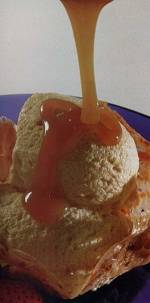Caramel Orange Sauce
{(rater>id=100|name=Caramel Orange Sauce|type=rate|headline=off)}
| Preheat: ° | Yield: servings | |
| Prep: 0:00 | Wait: 0:00 | Cook: 0:00 |
Ingredients
- 2 cups (1 lb.) sugar
- 2/3 cup (5 oz.) water
- 1 Tbs. corn syrup
- 4 oz. unsalted butter cut into 8 pieces
- 1/3 cup fresh orange juice (juice of 2 medium oranges)
- 1 to 2 Tbs. orange liqueur (optional)
Directions
- Combine the sugar and water in a saucepan. Gently stir until the mixture comes to a boil.
- Periodically during cooking, be sure to wash the sides of the saucepan with a clean pastry brush dipped in water.
- Once the mixture boils, stop stirring.
- Add the corn syrup and continue cooking over moderate to high heat until the mixture becomes a medium caramel color.
- Remove the pan from the heat and whisk in the butter piece by piece.
- Stir in the orange juice and liqueur.
- Allow to cool, then transfer to a clean container, cover, and refrigerate until needed.
Notes
To vary the flavor: Use a different juice in place of the orange juice, such as cherry, apple, or pineapple, or substitute another liqueur. For a creamier consistency, bring two ounces of heavy cream to a boil and blend into the finished sauce. Makes 1 3/4 cups.
GETTING THE FLAVOR RIGHT
Probably the most crucial part of making caramel is getting the sugar to the right stage. Stop the cooking too soon and the flavor doesn't have a chance to develop. Take it off too late and it's burnt. Once caramelization starts, it develops very quickly-the syrup can go from colorless to burnt in under a minute. Within this kind of time frame, another six or eight seconds can make a big difference.
To complicate matters further, simply taking the caramel of fhe stove doesn't stop the process. Residual heat in the pan and in the caramel itself continues the cooking, what I call carryover cooking. The greater the amount of caramel I'm making, the more carryover cooking there will be. To compensate for this, I'll stop a large batch a couple of shades shy of where I want it. Plunging the bottom of the pan into a metal bowl of ice water will take the heat out of the pan but not the caramel. For a small amount, this icy bath will pretty much curtail further cooking. Adding liquid ingredients will also stop the flavor from developing any further.
How dark is too dark? That depends in part on your taste and in part on how you're going to use the caramel. If the caramel flavor has to carry the dish, it should be rich and pronounced, but not so dark that it starts to pick up a bitter, almost burnt taste. I think it's especially critical for the flavor to be just right when making a caramel sauce, which can be used either as a delicious topping or as a major flavoring ingredient. When there are other ingredients to mellow the caramel flavor-for example, if I'm going to grind up the caramel and put it into ice cream, or if I'm adding nuts to make a brittle-I can get away with having the caramel a little on the dark side.
If the inside of your saucepan is dark, or if you're cooking a lot of caramel, the degree of caramelization can be difficult to distinguish. A simple way of monitoring the caramel is to test it against a piece of white paper (I use kitchen parchment) . I tear the paper in half, lay one piece next to the stove, and tear the other into five strips, which I then twist into tight spirals. Once I detect color in the syrup, I dip a paper twist into the pot and dab a little syrup onto the paper. As the color deepens, I repeat with another twist. It's easy to “read” the caramel stage
against the white paper.
How to Make Caramel
Although sugar dissolves in liquids even at low temperatures, it doesn't actually begin to melt until it's heated to 320°. At that point it also starts to pick up caramel flavors and colors. There are two ways I cook sugar to make caramel: a wet method and a dry method.
The wet method-To cook sugar using the wet method, I combine it with about one-third of its weight in water (say, two cups of sugar to two-thirds of a cup of water) . Then I bring the mixture to a boil while stirring gently over high heat. During cooking, I repeatedly wash down the insides of the saucepan with a clean pastry brush that has been moistened with cold water (preferably one
that hasn't been used with oil) . This is a very important step. If crystals of sugar are allowed to form on the inside of the saucepan, the entire mixture may crystallize.
Once the mixture boils, I stop stirring and add corn syrup. The exact amount will vary depending on the recipe. I continue boiling the syrup until it reaches the desired stage of caramelization.
Note:
Adding liquid ingredients or butter stops the process of caramelization. Because of the intense heat of the caramel, liquids also start to evaporate immediately When adding alcohol, like the orange liqueur going into the sauce, it' especially important to avoid the fumes, which can burn your eyes and nose.
STORING CARAMEL
Sugar is hygroscopic, meaning it attracts and retains moisture. The greater the percentage of sugar in the final caramel product, the more susceptible to humidity it will be. For example, the glaze on dipped fruits may start to deteriorate within half an hour because it's in contact with moisture. You can keep things like nut brittles or nougat cups fresh by storing them in airtight containers. Caramel sauce will keep well in the refrigerator for months.
Fine Cooking issue 1

